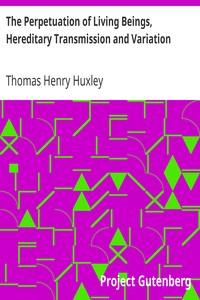Read this ebook for free! No credit card needed, absolutely nothing to pay.
Words: 9770 in 3 pages
This is an ebook sharing website. You can read the uploaded ebooks for free here. No credit cards needed, nothing to pay. If you want to own a digital copy of the ebook, or want to read offline with your favorite ebook-reader, then you can choose to buy and download the ebook.


: The Past Condition of Organic Nature Lecture II. (of VI.) Lectures to Working Men at the Museum of Practical Geology 1863 on Darwin's Work: Origin of Species by Huxley Thomas Henry - Evolution (Biology); Darwin Charles 1809-1882. On the origin of species
THE PAST CONDITION OF ORGANIC NATURE
by Thomas H. Huxley
IN the lecture which I delivered last Monday evening, I endeavoured to sketch in a very brief manner, but as well as the time at my disposal would permit, the present condition of organic nature, meaning by that large title simply an indication of the great, broad, and general principles which are to be discovered by those who look attentively at the phenomena of organic nature as at present displayed. The general result of our investigations might be summed up thus: we found that the multiplicity of the forms of animal life, great as that may be, may be reduced to a comparatively few primitive plans or types of construction; that a further study of the development of those different forms revealed to us that they were again reducible, until we at last brought the infinite diversity of animal, and even vegetable life, down to the primordial form of a single cell.
We found that our analysis of the organic world, whether animals or plants, showed, in the long run, that they might both be reduced into, and were, in fact, composed of, the same constituents. And we saw that the plant obtained the materials constituting its substance by a peculiar combination of matters belonging entirely to the inorganic world; that, then, the animal was constantly appropriating the nitrogenous matters of the plant to its own nourishment, and returning them back to the inorganic world, in what we spoke of as its waste; and that finally, when the animal ceased to exist, the constituents of its body were dissolved and transmitted to that inorganic world whence they had been at first abstracted. Thus we saw in both the blade of grass and the horse but the same elements differently combined and arranged. We discovered a continual circulation going on,--the plant drawing in the elements of inorganic nature and combining them into food for the animal creation; the animal borrowing from the plant the matter for its own support, giving off during its life products which returned immediately to the inorganic world; and that, eventually, the constituent materials of the whole structure of both animals and plants were thus returned to their original source: there was a constant passage from one state of existence to another, and a returning back again.
Lastly, when we endeavoured to form some notion of the nature of the forces exercised by living beings, we discovered that they--if not capable of being subjected to the same minute analysis as the constituents of those beings themselves--that they were correlative with--that they were the equivalents of the forces of inorganic nature--that they were, in the sense in which the term is now used, convertible with them. That was our general result.
And now, leaving the Present, I must endeavour in the same manner to put before you the facts that are to be discovered in the Past history of the living world, in the past conditions of organic nature. We have, to-night, to deal with the facts of that history--a history involving periods of time before which our mere human records sink into utter insignificance--a history the variety and physical magnitude of whose events cannot even be foreshadowed by the history of human life and human phenomena--a history of the most varied and complex character.
We must deal with the history, then, in the first place, as we should deal with all other histories. The historical student knows that his first business should be to inquire into the validity of his evidence, and the nature of the record in which the evidence is contained, that he may be able to form a proper estimate of the correctness of the conclusions which have been drawn from that evidence. So, here, we must pass, in the first place, to the consideration of a matter which may seem foreign to the question under discussion. We must dwell upon the nature of the records, and the credibility of the evidence they contain; we must look to the completeness or incompleteness of those records themselves, before we turn to that which they contain and reveal. The question of the credibility of the history, happily for us, will not require much consideration, for, in this history, unlike those of human origin, there can be no cavilling, no differences as to the reality and truth of the facts of which it is made up; the facts state themselves, and are laid out clearly before us.
But, although one of the greatest difficulties of the historical student is cleared out of our path, there are other difficulties--difficulties in rightly interpreting the facts as they are presented to us--which may be compared with the greatest difficulties of any other kinds of historical study.
What is this record of the past history of the globe, and what are the questions which are involved in an inquiry into its completeness or incompleteness? That record is composed of mud; and the question which we have to investigate this evening resolves itself into a question of the formation of mud. You may think, perhaps, that this is a vast step--of almost from the sublime to the ridiculous--from the contemplation of the history of the past ages of the world's existence to the consideration of the history of the formation of mud! But, in nature, there is nothing mean and unworthy of attention; there is nothing ridiculous or contemptible in any of her works; and this inquiry, you will soon see, I hope, takes us to the very root and foundations of our subject.
How, then, is mud formed? Always, with some trifling exception, which I need not consider now--always, as the result of the action of water, wearing down and disintegrating the surface of the earth and rocks with which it comes in contact--pounding and grinding it down, and carrying the particles away to places where they cease to be disturbed by this mechanical action, and where they can subside and rest. For the ocean, urged by winds, washes, as we know, a long extent of coast, and every wave, loaded as it is with particles of sand and gravel as it breaks upon the shore, does something towards the disintegrating process. And thus, slowly but surely, the hardest rocks are gradually ground down to a powdery substance; and the mud thus formed, coarser or finer, as the case may be, is carried by the rush of the tides, or currents, till it reaches the comparatively deeper parts of the ocean, in which it can sink to the bottom, that is, to parts where there is a depth of about fourteen or fifteen fathoms, a depth at which the water is, usually, nearly motionless, and in which, of course, the finer particles of this detritus, or mud as we call it, sinks to the bottom.
Or, again, if you take a river, rushing down from its mountain sources, brawling over the stones and rocks that intersect its path, loosening, removing, and carrying with it in its downward course the pebbles and lighter matters from its banks, it crushes and pounds down the rocks and earths in precisely the same way as the wearing action of the sea waves. The matters forming the deposit are torn from the mountain-side and whirled impetuously into the valley, more slowly over the plain, thence into the estuary, and from the estuary they are swept into the sea. The coarser and heavier fragments are obviously deposited first, that is, as soon as the current begins to lose its force by becoming amalgamated with the stiller depths of the ocean, but the finer and lighter particles are carried further on, and eventually deposited in a deeper and stiller portion of the ocean.
It clearly follows from this that mud gives us a chronology; for it is evident that supposing this, which I now sketch, to be the sea bottom, and supposing this to be a coast-line; from the washing action of the sea upon the rock, wearing and grinding it down into a sediment of mud, the mud will be carried down, and at length, deposited in the deeper parts of this sea bottom, where it will form a layer; and then, while that first layer is hardening, other mud which is coming from the same source will, of course, be carried to the same place; and, as it is quite impossible for it to get beneath the layer already there, it deposits itself above it, and forms another layer, and in that way you gradually have layers of mud constantly forming and hardening one above the other, and conveying a record of time.
Free books android app tbrJar TBR JAR Read Free books online gutenberg
More posts by @FreeBooks


: Strife: A Drama in Three Acts by Galsworthy John - Strikes and lockouts Drama; Social conflict Drama; English drama; Political plays; Tinplate industry Drama; Labor movement Drama


: The Perpetuation of Living Beings Hereditary Transmission and Variation Lecture IV. (of VI.) Lectures to Working Men at the Museum of Practical Geology 1863 on Darwin's Work: Origin of Species by Huxley Thomas Henry - Evolution (Biology); Darwin Charles 1





